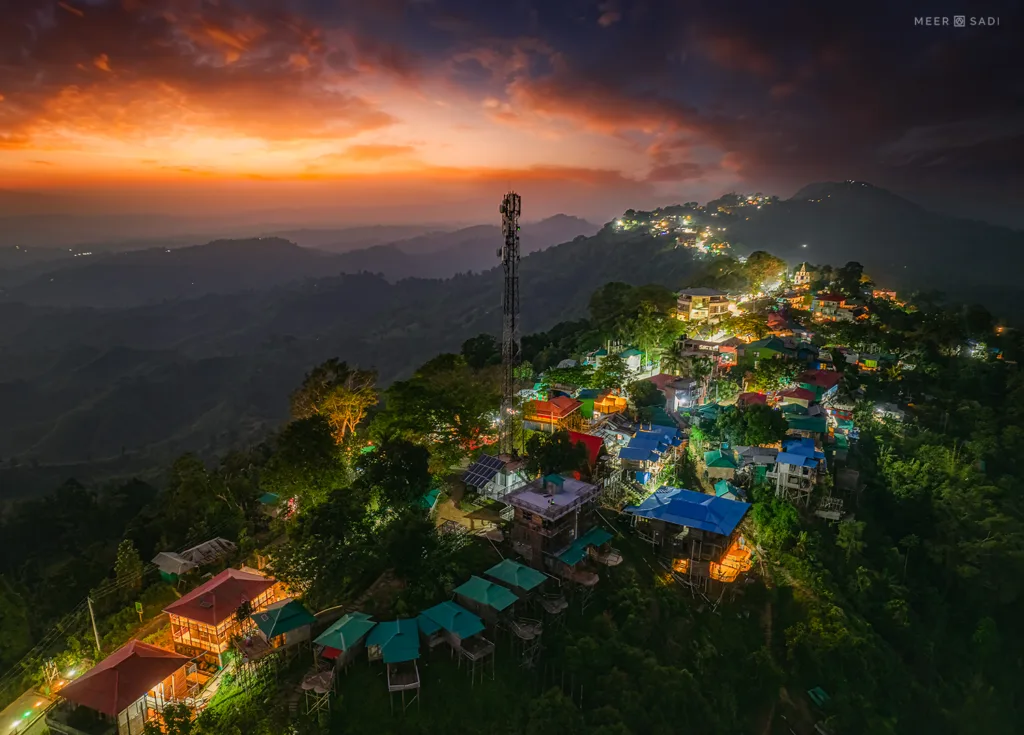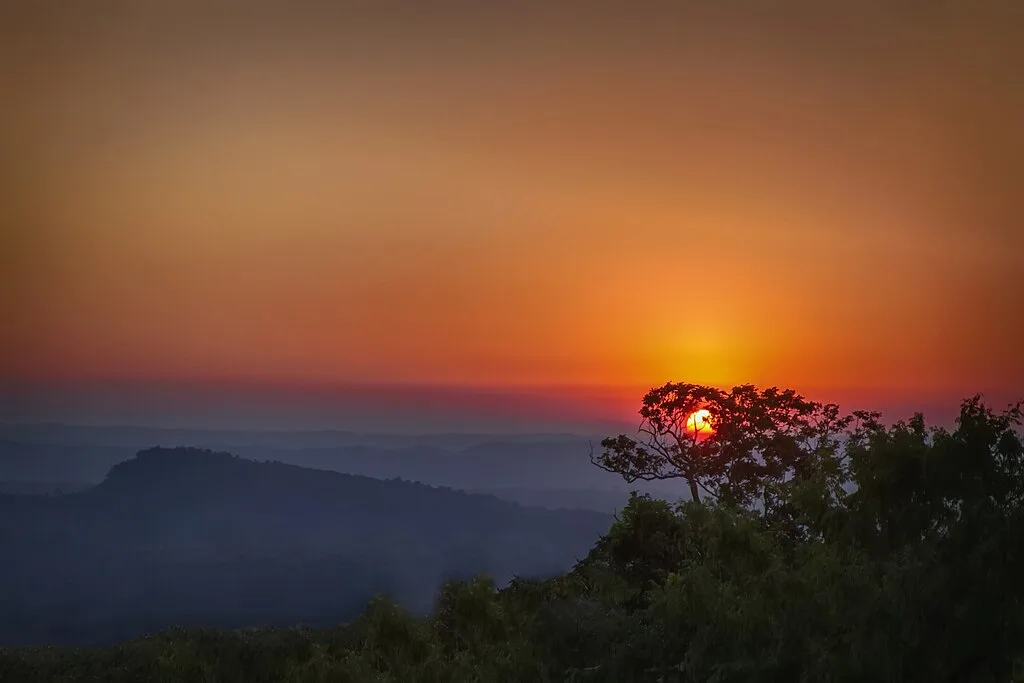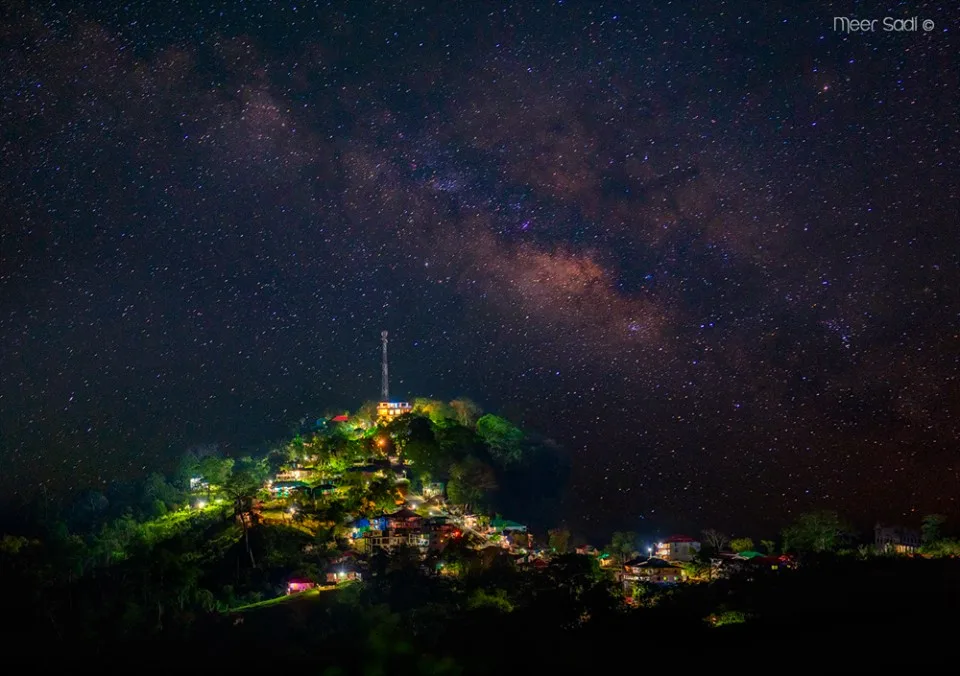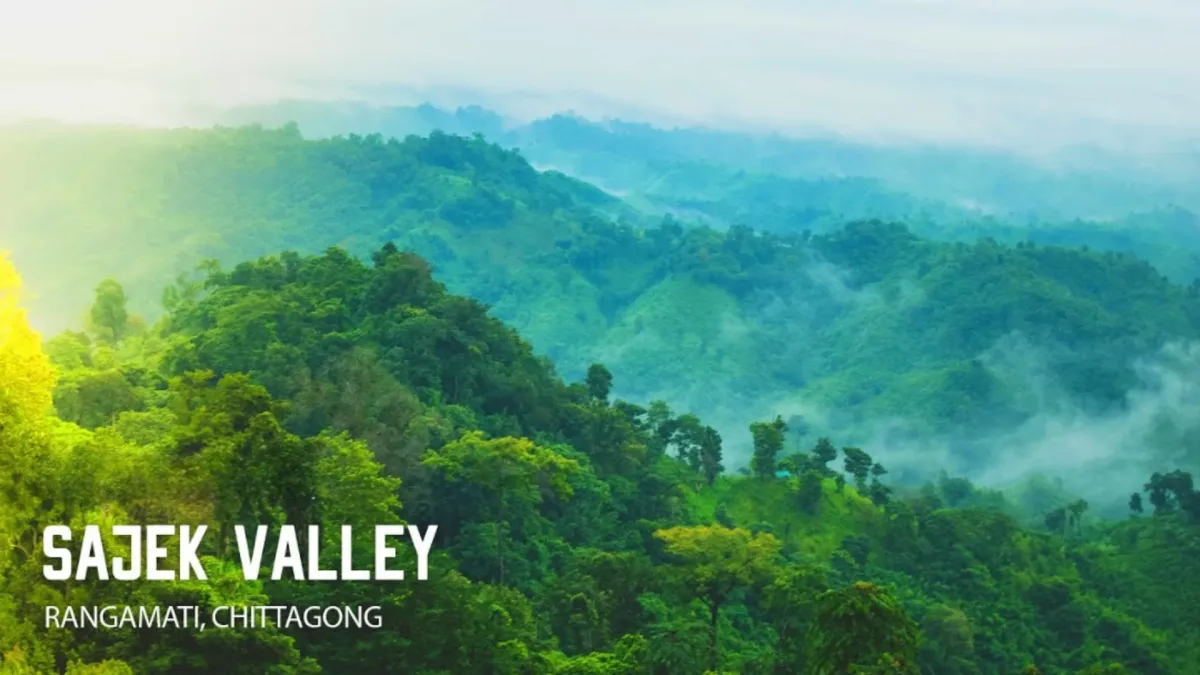The Sajek Valley, an emerging tourist destination in Bangladesh, is located among the Kasalong mountain range in the Sajek Union of the Baghaichhari Upazila in the Rangamati District. The valley sits 1,476 feet (450 meters) above sea level. It is known as the “Queen of Hills” and the “Roof of Rangamati.”

It is located in the lush hills of the Kasalong mountain range amidst serene and exotic natural beauty. The valley features lofty mountains, dense forests, sprawling grasslands, and miles of hilly tracks. Visitors will enjoy the simple and basic indigenous lifestyle of the local people.
Contents
ToggleThe Sajek Valley
The Sajek Valley is known for its natural beauty. It is surrounded by green mountains, dense forests, and rolling hills. Many small rivers flow through the mountains, the most notable of which are the Sajek (also known as the Kasalong) and the Masalong. To reach Sajek Valley, travelers must cross the Mayni Range and the Mayni River.
The valley is known as the “Queen of Hills” and the “Roof of Rangamati.” The valley is surrounded by mountains, dense forests, grasslands, hilly terrain, and many rivers. Sajek Valley is one of the best travel destinations in Bangladesh.

Read More: Exploring Tanguar Haor: Best Haor Tour in Bangladesh
Attractive Places in Sajek
The beautiful mountains and the valley of clouds resembling white cotton will surely fascinate you. Sajek is a wonderful place surrounded by three types of nature. Sometimes it is hot, sometimes it rains, and sometimes thick fog covers the landscape in an instant. The Sajek Valley Tour is ideal for viewing the fluttering, hilly clouds that resemble natural landscapes and cotton.
Konglak Hill is a major tourist attraction in Sajek. Konglak is the last village in the Sajek Valley and is inhabited by the Lusai community. From Konglak Hill, you can see where the Karnafuli River begins in the Lusai Hills of India. If you trek through Ruilui Para for two hours, you can see the Kamalak fountain. This beautiful fountain is also known as Padaam Toisha Jharna or Sikam Toisha Jharna.

Sajek is like an awesome painting by an artist. As time passes, Sajek does not grow old. If you go to Sajek, don’t miss the sunrise. The white clouds and sunrise/sunset light create an amazing atmosphere. To see the sunrise, go to Hollypad early in the morning. In the afternoon, the sunset from a highland will captivate you. After evening falls, the billions of stars in the sky will shine and awe you. If the sky is clear, you may be able to see the Milky Way or other galaxies. You can explore and experience the lifestyle of the indigenous people.

You will have unforgettable experiences when you interact with these simple people. When you return from Sajek Valley, you can visit the Hazachara Jhorna, the Dighinala hanging bridge, and the Dighinala Banbihar.
How to Get There?
Though Sajek is located in the Rangamati district, it is much easier to travel there from Dighinala in the Khagrachari district. First, come to Khagrachari. If you are coming from Dhaka, you can take a bus with Saudia Paribahan, Shyamoli, Shanti Paribahan, S. Alam, Eagle, and so on. A non-AC bus will cost you nearly BDT 520. If you prefer an AC bus, you can take BRTC or Saint Martin Paribahan for BDT 700 to 900. Additionally, Shanti Paribahan goes directly to Dighinala, costing only BDT 580. You can find ticket counters for these buses at various locations around the city, including Gabtali and Kalabagan in Dhaka. If you plan to travel during a holiday, it may be difficult to get a ticket unless you buy it in advance.

The distance between Khagrachari and Sajek is about 70 km. You can visit Sajek Valley by reserving a jeep or chander gari in Khagrachari. The round-trip fare is BDT 8,000 to 10,000. This option is perfect for 12 to 15 people. However, if you are in a small group, join another group to reduce the cost. If that is not possible, you can take a CNG. It will cost between BDT 4,000 and 5,000. However, it is better not to travel by CNG because the roads are very winding.
Dhaka to Khagrachari (Sajek)
Although Sajek is in the Rangamati district, it is easier to travel there from Khagrachari. First, come to Khagrachari. To get there from Dhaka, you can take a bus with Saudia Paribahan, Shyamoli, Shanti Paribahan, S. Alam, Eagle, and so on. A non-AC bus will cost you nearly BDT 520. If you prefer an AC bus, you can take BRTC or Saint Martin Paribahan for BDT 700 to 900. Additionally, Shanti Paribahan goes directly to Dighinala, costing only BDT 580. These buses have counters at various locations around the city, including Gabtali and Kalabagan in Dhaka. If you want to travel during a holiday, it may be difficult to get a ticket unless you buy one in advance.
Khagrachari to Sajek
The distance between Khagrachari and Sajek is about 70 kilometers. You can visit Sajek Valley by reserving a jeep, gari, or chander gari in Khagrachari. The return fare costs between BDT 8,000 and 10,000. This option is perfect for groups of 12 to 15 people. However, if you are in a small group, consider joining another group to reduce the cost. If that is not possible, you can take a CNG. It will cost between BDT 4,000 and 5,000. However, it is better not to travel by CNG because the road is very winding.
If you are traveling alone or with only two to three people, many groups are available at Khagrachari Shapla Chattor. There, you can talk to other groups or share your experiences with the Zip Association office. They will find another group for you.
You can also visit Sajek by going from Khagrachari to Dighinala first. Dighinala is 23 km from Khagrachari. The bus costs BDT 45, and a motorcycle costs BDT 100 per person. You can also rent a motorcycle to travel to Sajek. Before hiring a car or bike, discuss in detail what you want to do and see.
It’s important to keep in mind that you must reach Dighinala before 10 a.m. You will need an army escort for the rest of the road from Dighinala for safety reasons. Army escorts are available twice a day: Once at 10:00 a.m. and again in the afternoon.
If you miss the morning escort, you must wait until the afternoon. If you miss the afternoon escort, you must wait until the next day. Without an escort, you will not receive permission to leave. When you reach Dighinala, you can visit Hazagarh Jhorna if you have extra time.
On the way from Dighinala to Sajek, you will pass through Bagaihat and Machalong Bazar, then Ruilui Bazar. The journey from Khagrachari city to Sajek takes two to three hours. The rows of hills and green skyline will make you forget all your road fatigue.
Rangamati to Sajek
Both launches and buses left Rangamati for Baghaichhari via the waterways and roadways. Launches depart from Reserve Bazar Ghat between 7:30 and 10:30 a.m. The journey takes four to five hours. Additionally, buses leave from the Rangamati bus terminal between 7:30 and 8:30 a.m. The journey takes five to six hours. Alternatively, you can go directly to Baghaichhari from Dhaka or Chittagong. In Baghaichhari, jeeps, motorcycles, and chander garis are available to reach the Sajek Valley.
Chittagong to Sajek
From Chittagong, you can go to Khagrachari or Dighinala to reach Sajek. Four BTRC AC buses leave Kadamtoli in Chittagong daily for Khagrachari. Additionally, buses from Shanti Paribahan leave Oxyzen Mor in Chittagong every hour. The trip from Chittagong to Khagrachari takes 4 to 5 hours.
What is the best time to visit Sajek Valley?
The best time to visit Sajek Valley is from October to April during the dry season. You can also visit in the fall. During this time, you can enjoy pleasant weather, clear skies, and stunning sunrise and sunset views. It’s the perfect time to explore the valley and enjoy outdoor activities like hiking and camping.
Winter (November – February)
This is a popular time to visit Sajek due to the cool, comfortable weather and clear skies, perfect for enjoying the scenic views and sunrises.
Spring (March – April)
The weather is warm and pleasant, with blooming flowers and lush green hills, offering a different kind of beauty compared to the winter months.
Rainy Season (May – September)
While Sajek can be beautiful in the rainy season with clouds and misty views, it can also be challenging due to potential landslides and transportation difficulties.
The Perfect Time to Visit Sajek Valley
Sajek is beautiful year-round. Each season brings a new, attractive color to the valley. So, no matter if you are going in the summer or winter, you will experience Sajek differently. However, during the rainy season and late autumn, you will feel the white clouds very closely. Therefore, these are considered the best times to visit Sajek Valley.
Where will you stay?
There are more than 40 resorts and cottages in Sajek where you can spend the night. If you want a quality room, it is better to book at least a month in advance. If you’re looking for a lower price, the indigenous cottages might be a good option. Additionally, new cottages are being built that consider the environment. All of the cottages offer beautiful views of Sajek. We have made an efficient list of the most popular resorts and cottages, including Sajek Resort, Runmoy Resort, Megh Mechang, Jumghor Eco Resort, TGB Lushai Cottage, Meghpunji Resort, Resort Rungrang, and Alo Resort.
What will you eat?
All the resorts have food services, so if you inform them in advance, they will cook according to your preferences. Meals cost nearly BDT 100 to 200. You will find rice, flour, chicken, and other items on the menu. If you would like, you can arrange a barbecue tonight. You can also eat at indigenous people’s houses. Just tell them what you want, and they will offer you the best food. Fruits such as papaya, pineapple, and bananas are very cheap, so be sure to try them.
Tips for Traveling to Sajek
- Before going, make sure to book your room by phone. This will help you avoid hassle during holidays or off-season.
- There is no electricity in Sajek. Though there are solar charging options, they take longer and are not easily available. It is a good idea to bring a power bank.
- In Sajek, only the Robi, Airtel, and Teletalk networks are available.
- The road to Sajek is very steep and winding, so it is dangerous. Be careful about traveling on the roof of the jeep.
- In Sajek, you don’t need a guide.
- Ask for permission before taking photographs of indigenous people. Do not take pictures without permission.
- The indigenous people are very simple and honest. Always respect their lifestyle, beliefs, and culture.
- There are security camps along the way to Sajek. They need information about travelers. Cooperate for your own safety. Keep a copy of your national identity card.
- Marayong Thong, Bandarban.
- If you plan to stay more than two or three days, instead of keeping the car with you, just arrange for the car to be taken away. Then, come back with another vehicle or return to Dighinala by renting a car.
This is a remote, hilly area, so keep necessary items and emergency medicine with you. Do not throw chips, packets, or waste in the hills. Keep it in the right place. This is our pride, so we must keep it clean.
What is the best time to visit Sajek Valley?
The best time to visit Sajek Valley is from October to April during the dry season. You can also visit in the fall. During this time, you can enjoy pleasant weather, clear skies, and stunning sunrise and sunset views. It’s the perfect time to explore the valley and enjoy outdoor activities like hiking and camping.
What is the price of the Sajek Valley Tour?
The lowest price of the Sajek valley tour package in Bangladesh is Tk 7,000 only.
Can we go to Sajek by train?
There is no direct train from Dhaka to Sajek Valley. However, you can take the train to Feni, and then a taxi to Sajek Valley. Alternatively, you can take a bus to Chittagong and then a taxi to Sajek Valley.
What is special about Sajek Valley?
The Sajek Valley is known for its natural beauty. It is surrounded by green mountains, dense forests, and rolling hills. Many small rivers flow through the mountains, the most notable of which are the Sajek (also known as the Kasalong) and the Masalong. To reach the valley, travelers must cross the Mayni Range and the Mayni River.

